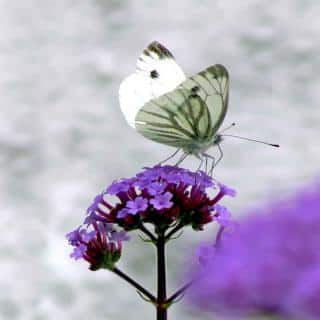

Purpletop vervain grows beautifully in gardens all over the world.
Argentinian vervain facts :
Botanical name – Verbena bonariensis
Common name – Argentinian verbena, Purpletop vervain
Family – Verbenaceae
Type – perennial, grown either as an annual or a biennial
Bearing – disorderly, upright mound
Height – 3 to 4 feet (1 m to 1.20 m)
Planting density – 4 to 6 plants per sq. yard (m²)
Exposure – full sun
Soil – any type, as long as well drained
Flowering – from July to October
Its airy and vaporwave blooming bring a touch of lightness to the garden, perfect for dressing up the back of a flower bed without overloading it. It isn’t very resistant, but that’s more than made up for thanks to abundant seeds that self-sow. Discover more about Argentinian vervain!
Verbena bonariensis requires growing in full sun if you want it to bloom abundantly. It also fears excess water. You’ll have to really make sure that the soil drains well enough. Just like stonecrop and centaury, the Buenos Aires verbena will settle in just fine in all types of soil, so it’s often selected for difficult situations. To plant Verbena bonariensis, it’s easiest to simply start them from seeds anytime in March, April. If ever they sprout too close to one another, thin them to a distance of about 1½ feet (40 cm): this will let each plant thrive on its own.
Once flowers have wilted away, cut them off above the leaves to trigger another round of blooming. If you’re trying to grow your Argentinian Verbena in pots, one point of caution is to watch soil moisture: watering should be moderate, but regular. At the beginning of spring, cut the stems back to the base. If ever winter isn’t too harsh, they’ll bud and sprout back to life in spring. If not, no worry: seeds will start sprouting, too.
Simple and straightforward: just let this verbena re-seed itself on its own. For that, come fall, don’t cut the last flowers off their stem. Let them form seeds instead, they’ll scatter around naturally.
Aphids are definitely fond of infesting Argentina verbena. If ever the onslaught is so severe that the plant is in danger, spray a mix of watered-down beldi soap on all the leaves.

It’s worth giving growing it in pots a go, but for that you must select a container that’s large enough to house all of its roots – and heavy enough that it won’t topple over when wind pulls on its long stems.
Argentinian verbena is an abundantly melliferous plant: this makes it ideal not only to attract bees, but butterflies, too!